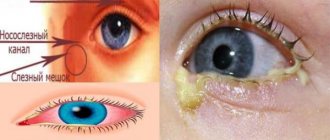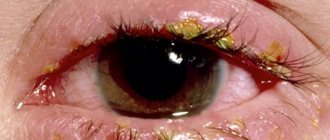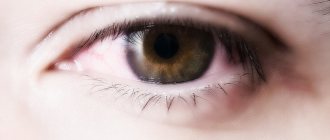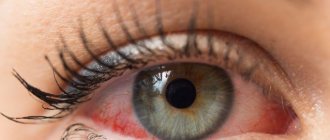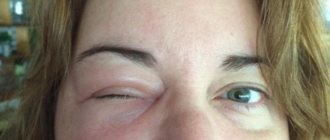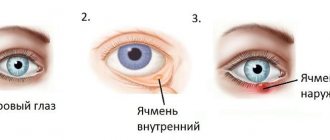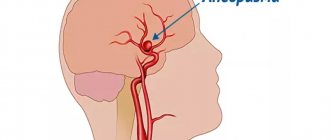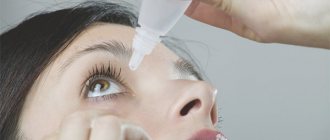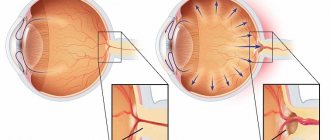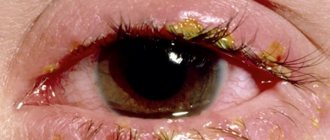- October 16, 2018
- Ophthalmology
- Smirnova Alexandra
In this article we will look at the reasons why the eyelid may swell above the eye.
In the morning you can often see that your eyes are swollen. If such a symptom is also accompanied by pain, this becomes a cause of fear and panic, and worries about health. How dangerous is this? What to do if the upper eyelid is painful and swollen, in order to prevent serious consequences? First of all, you need to determine the causes of this disease.
Causes
Often the appearance of a situation where the eyelid is swollen above the eye can be caused by drinking a lot of liquid before going to bed. By washing your face and applying a lotion of tea, you can get rid of this problem. If the upper eyelid hurts and is swollen, then the reasons may be the following:
- Allergy. During active flowering of plants, people are prone to allergic reactions, and swelling may occur above the eye. If you do not take an antihistamine, a complication such as Quincke's edema may develop. What are other causes of a swollen eyelid?
- The process of inflammation. Any eye pathology that occurs with an inflammatory process causes swelling over the organ of vision.
- Cold. Very often during colds it is observed that the eye is swollen and the upper eyelid hurts. This is due to the fact that during the disease the sinuses swell and lacrimation increases.
If a person’s eyelid is swollen above the eye, then this may be the first symptom of: meibomitis; dacryoadenitis; conjunctivitis.
Methods of treatment if the upper eyelid hurts, is swollen and swollen
Treatment methods depend on the cause of swelling of the skin under the eyes:
- if the eyelid is swollen as a result of drinking too much liquid the day before, cold tea compresses, cucumber and potato masks will come to the rescue;
- a specific drug is selected for the treatment of inflammatory diseases;
- lack of sleep, bad habits, lack of vitamins can be corrected by lifestyle changes;
- For eye injuries, first aid measures include lotions with chamomile or linden decoctions. Antibacterial drops and painkillers are used to prevent infections. It is recommended to go to the hospital immediately;
- allergic reactions require the use of antihistamines.
Edema can be removed in various ways, including medications, traditional medicine methods, and cosmetics.
Folk recipes
Effective ways to combat swollen eyelids at home are:
- Cold compresses. For lotions, you can use either ordinary chilled water, soaking cotton pads in it, or frozen pieces of ice wrapped in cloth. Keep the compress on your eyes for no more than 20 minutes, otherwise you can overcool the epidermis.
- An effective remedy is a tea compress, which will help remove swelling caused by alcohol abuse. Tea bags are placed on problem areas for 15 minutes.
- Decoctions of chamomile, sage, calendula, and linden, which have anti-inflammatory properties, cope well with swelling. To prepare, you will need to dissolve one tablespoon of the herb in a glass of boiling water, leave for 15 minutes and filter. Soak a cotton swab in the resulting liquid and keep it on your eyes for at least 30 minutes.
- If the upper eyelid is swollen as a result of fluid retention in the body, you can drink diuretic herbs. Before use, you should consult your doctor. Among the well-known plants that help remove excess fluid are: birch buds, lingonberries, flaxseed, parsley seeds. The herbal infusion is taken daily for several days. To prevent potassium excretion, you must adhere to a certain diet during treatment: include beans, potatoes, bananas, prunes, spinach, pumpkin, and oranges in your diet.
- You can cope with swelling using a mask made from parsley. The plant is crushed, mixed with sour cream and placed on cleansed skin for 10 minutes.
- You can hide signs of overwork with a chocolate mask. To do this, dark chocolate is melted, mixed with cream and lubricated on the problem area. Leave for 15 minutes, then wash with cool water.
Alternative medicine methods can help with non-inflammatory causes of edema. Before using traditional recipes, you should consult a specialist.
Conservative therapy
Drug therapy is used for inflammatory and infectious causes of swelling. It is necessary to treat swelling depending on the type of disease:
- for barley, eye ointments Tetracycline and Erythromycin, as well as antiseptic drops Okomistin are used;
- antimicrobial agents (Tobrex, Albucid, Levomycetin, Floxal) will help cure conjunctivitis;
- Pathologies of a purulent nature require the use of antibacterial medications, both internally and locally. Ceftriaxone can be prescribed for intravenous administration; Erythromycin, Signicef, Tobrex, Albucid are used as eye ointments and drops;
- For dermatitis and allergic manifestations, complex therapy is required. For this purpose, enterosorbents (Enterosgel, Smecta) and antiallergic drugs (Claritin, Cetrin) can be prescribed. In severe cases, hormonal medications (Dexamethasone, Hydrocortisone) are used. Allergodil drops are suitable for local administration;
- if the eyes are swollen as a result of penetration of a foreign object, Visin drops will help relieve swelling;
- To reduce pain from burns and injuries, Novocaine, Lidocaine drops, as well as lotions from anti-inflammatory infusions are used;
- if the edema is viral, antiviral agents are used, for example, Acyclovir ointment. Physiotherapy is an auxiliary treatment method.
Diseases of the internal organs that cause swelling are treated by certain specialists. If you have kidney problems, you should consult a general practitioner and nephrologist. If the functioning of the heart and blood vessels is impaired, it is necessary to consult a cardiologist. Hormonal disorders are treated by an endocrinologist. If you suspect cancer, you should contact an oncologist.
Cosmetical tools
If the cause of swollen eyelids is not hidden in serious pathologies, you can try to eliminate the problem with the help of cosmetics. The range of modern creams and ointments for puffiness under the eyes is very wide: on store shelves you can choose a product depending on your budget:
- An inexpensive remedy for puffiness and bags under the eyes - “Green Pharmacy”. The cream contains horse chestnut extract and rutin. Strengthens vascular walls, eliminates swelling. Cost about 100 rubles.
- Cream-gel for eyelids “Bark” based on caffeine, seaweed, oils, and vitamin E. It will help relieve swelling and smooth the skin. Price 400-500 rub.
- Clinique. Serum for bags under the eyes based on caffeine and other natural ingredients. It will help relieve swelling and get rid of dark circles. Price - from 2000 rub.
Pharmaceutical creams and ointments designed to solve other problems also cope well with swelling - Solcoseryl, Proctonis, Retinoic ointment, Curiosin, Zinc ointment, Blepharogel, Relief, Heparin ointment, Troxevasin, Traumeel.
Physiotherapeutic procedures (mesotherapy, electrical stimulation, vacuum or roller massage) have shown excellent results, which have a beneficial effect on eye tissue and stimulate the removal of excess fluid.
Among women
In addition, women who use poor quality cosmetics, as well as those who suffer from hormonal imbalance or impaired water metabolism, face swelling of the upper eyelid. In some cases, the eyelid swells and the eye hurts after prolonged crying. This is mainly faced by people with thin and sensitive skin.
A situation where the eyelid is swollen above the eye can be caused by pathologies of the heart and vascular system. For example, this is a common sign of chronic heart failure.
How does the symptom manifest itself in the morning after sleep?
Sometimes, waking up and dreaming of seeing a rested face in the mirror, a person cannot recognize his reflection. The eye area is rounded, the eyelids are heavy, and the skin is unpleasantly stretched. There are several types of manifestation of the problem. Let's look at the ones everyone knows:
- Bags under the eyes appear with age as a result of the accumulation of fat under the skin and “wear and tear” of soft tissues. The area in the eye area is subject to daily stretching in the process of expressing facial expressions, and also bears stress during blinking.
- Bruises are the result of stress, sleepless nights or exhaustion. They are often a consequence of a long illness, even after recovery. Dark circles are also included in the list of symptoms of ailments such as anemia, vitamin deficiency, kidney failure and others.
- Edema - expressed by swelling of the upper or lower eyelid, sometimes both. They arise due to the accumulation of excess fluid in the interstitial layer. Unlike bags, with the use of therapeutic or preventive measures, they are removed without a trace.
We will talk about why eyes swell in the morning and how to deal with it in this article.
Tumors as a source of eyelid swelling
Many people are interested in why the eyelid above the eye is swollen.
The reason for this phenomenon may be hidden in the formation of a cyst, a low-quality or benign tumor. There have been cases in medical practice when a tumor of the upper eyelid appeared due to a tumor such as molluscum contagiosum. The swelling looks like a small pearl. This disease usually goes away on its own, but sometimes it is cauterized or squeezed out. When the eyelid is swollen and painful, and its color is yellowish, we are talking about xanthelasmas - formations that are accumulations of lipids in the medial part of the eyelids.
The most popular tumor that appears on the eyelid and threatens health is basal cell carcinoma. It will not go away on its own, and a person may lose vision if not treated properly.
Cosmetic defect as a result of illness
What diseases cause dark eyelids? Here are a number of such ailments:
- If the lower eyelids have a bluish tint, this indicates an imbalance in the water balance in the body or water retention due to an excess of sodium salts or due to anemia (iron deficiency). Or, on the contrary, blue circles under the eyes indicate dehydration.
- Stones in the biliary tract or kidneys.
- Disturbances in the functioning of the circulatory system.
- Sinusitis.
- Liver disorders.
- Cardiovascular diseases.
Only a doctor can identify these reasons. And if dark circles appear around the eyes, you should first be examined at the clinic. If no such problems are found, then the reason for the darkening of the skin of the eyelids lies in something else.
Signs of allergies
Allergic swelling may appear on both the lower and upper eyelids. The reaction to the allergen either appears immediately or after some time.
The distinctive symptoms are:
- itching sensation;
- painlessness;
- burning;
- redness is possible.
In individual cases, in addition to the typical signs, other symptoms may be noted: low-grade fever, general weakness, irritation.
Reactive edema, which occurs suddenly and for no reason, most often indicates an allergic reaction. This condition is mainly characterized by Quincke's edema, or angioedema. It is characterized by diffuse or limited swelling, which can spread to the cheek and go down below. The patient does not experience any painful sensations as such. Patients may complain of severe itching and tissue tension. Being a fast-type reaction, angioedema disappears on its own after a short time. However, in the presence of an allergen, this swelling of the eyelid can recur from time to time or develop into a more serious form when other mucous bodies and membranes of the eye are involved.
So, the eyelid above the eye is swollen, what should you do?
What is eyelid swelling
This is a symptom that represents an excessive accumulation of fluid in the subcutaneous fatty tissue of the eyelids, resulting in their swelling. The common cause of this pathology is various diseases of a local or general nature. Swelling of the upper eyelid is most common, but sometimes it also occurs in the lower eyelid. The attack can be single or recurrent. Edema can develop at any age, but men and women over 30 are more prone to it.
In general, the eyelid is a fold of skin that protects the eyes from possible dangers, such as dust and bright flashes. It consists of two layers:
- Anterior, or superficial . This is the musculocutaneous layer that provides blinking. The muscle includes two parts: palpebral and orbital.
- Posterior, or deep . This is the conjunctival-cartilaginous layer. The cartilage of the eyelids consists of dense connective tissue located under the eye muscles.
Most of the human body is fluid. It occupies almost 70% of the total volume. Part of the fluid is located inside the cells, the rest is in the space between them. Swelling of the eyelid in one eye develops when the amount of water in the intercellular area becomes above a critical value of 1/3 of the total volume. Depending on the reason it happens:
- membranogenic - develops due to increased permeability of vascular walls to water and molecular substances;
- hydrostatic – associated with a decrease in the pressure of the same name inside the capillaries and tissues;
- hypoproteinemic - is a consequence of a decrease in colloid osmotic pressure.
Depending on the location, swelling is divided into bilateral and unilateral (on the right or left eye). These types are practically no different. Swelling of the lower eyelid is observed less frequently; swelling of the upper eyelid occurs more often. In the first case, cardiovascular diseases may be a serious cause. Taking into account the cause, edema is classified into:
- Inflammatory . Accompanied by pain, redness, and hyperemia of the skin. This type of inflammation is characteristic of eyelid swelling in one eye.
- Allergic . Also called angioedema. The eyelid doesn't hurt, it just itches. There are no other symptoms. When a child's upper eyelid is swollen, the most common cause is allergies.
- Non-inflammatory . The skin color remains normal or pale, there is no pain, as well as a local increase in temperature. Swelling of this type is often bilateral and occurs mainly in the morning.
- Traumatic . Characteristic of the condition after tattooing, in which pigment is driven under the skin to create a makeup effect. The cause can also be other trauma to the eyelids, for example, microtrauma when wearing contact lenses.
Inflammatory edema
This type of deviation is associated with infectious lesions of the eyes, and less often with other diseases, such as acute respiratory viral infections, sinusitis, sinusitis and other inflammations of the sinuses. Such pathologies are accompanied by:
- burning;
- itching;
- tingling;
- photophobia;
- tearfulness.
Similar symptoms in the case of colds develop more often in both eyes. If only one eyelid is swollen, then the likely cause is infectious pathologies of the organs of vision. The list of such diseases includes:
- Barley . It is formed after pathogenic bacteria, most often Staphylococcus aureus, enter the surface of the eyeball. The infection is an inflammation of the hair follicle of the eyelashes. The eyelid turns red, swells, and hurts when pressed.
- Conjunctivitis . Inflammation develops in the mucous membrane of the eye. Redness appears. There is a feeling of a foreign body or sand in the eye. There is photophobia and discharge of pus or clear fluid.
- Blepharitis . This is a chronic disease accompanied by inflammation of the edge of the eyelids, which swells.
- Dacryocystitis . Characterized by inflammation of the lacrimal sac. Dacryocystitis is indicated by pain, redness, and swelling of the eyelids. Symptoms are localized closer to the inner edge of the eye.
- Infectious and inflammatory diseases . These include abscess and phlegmon of the orbit, which develop as a result of bacteria entering the wound. In this case, the eyelid swells and hurts very much. In more severe cases, body temperature rises, general weakness and headache appear.
- Erysipelas lesions . This is a serious infectious disease that causes general intoxication of the body and inflammatory skin lesions. It can also cause swelling of the eyelid in one eye.
Allergic swelling of the eyelids
The clinical picture of allergic edema of the eyelid in one eye differs from inflammatory edema. Symptoms develop suddenly. Itching and swelling appear on the eyelid, it turns red. A person feels discomfort in the area of the affected eyeball. Skin rash, nasal congestion, and tearfulness also indicate the allergic nature of the disease. This reaction can be caused by:
- household chemicals;
- cosmetical tools;
- animal hair;
- plant pollen;
- insect vinegars;
- food products;
- hygiene products.
Allergic edema is classified into two types based on the symptoms and their severity. Based on these characteristics, the following are distinguished:
- Allergic dermatitis . Accompanied by not very strong swelling. Characteristic symptoms are itching and redness.
- Quincke's edema . Unlike the previous type, on the contrary, it causes severe swelling, which does not even allow a person to open his eyes. There are no other signs. This condition is dangerous because it can spread to the respiratory system.
Traumatic edema
Due to the soft and very delicate tissue, the eyelids are easily injured. Swelling may appear as a result of a burn, bruise or other mechanical stress. No specific treatment is required. Therapy is aimed at reducing symptoms and preventing purulent complications. This requires maintaining eye hygiene. There are other causes of traumatic swelling:
- Tattoo procedure . Involves driving pigment under the skin. Swelling develops due to too deep exposure. If the procedure is carried out correctly, the symptom disappears on its own after a day.
- Anatomical structure of the organs of vision . If the membrane between the fat layer and the skin is too thin, then it can swell under any negative influence.
- Chicken nuggets: homemade recipes
- Pumpkin seeds - benefits and harm. How to take pumpkin seeds for men and women to treat diseases
- Products containing vitamin D
Non-inflammatory edema
This type of deviation is most often observed in the morning after waking up. In this case, swelling of the eyelids above the eyes is accompanied by severe pain, redness and hyperemia of the skin. At the same time, the external skin looks pale and cool. The cause of this complex of symptoms may be:
- oncological eye diseases;
- violation of lymph outflow or blood circulation;
- systemic diseases of the thyroid gland, vascular system, kidneys, digestive system;
- abuse of salty foods;
- smoking and drinking alcohol;
- lack of sleep;
- eye strain.
Swelling of the eyelids in the morning
At night, fluid gradually fills the space between the cells. This occurs due to prolonged exposure to a horizontal position. Then the swelling goes away throughout the day. The main causes of pronounced swelling after sleep, which occurs regularly, are:
- diseases of the genitourinary system;
- abuse of pickles and alcohol the day before;
- first use of a new cosmetic product.
Which doctor should I go to?
Whatever the cause of swelling of the eyelids and puffiness of the eyes, the best decision would be to consult a doctor for help. The specialist will be able to quickly assess the current situation, determine the cause and choose individual treatment.
Eye diseases are subject to the department of an ophthalmologist (ophthalmologist). However, if you cannot get to him in the near future, you should at least contact your local physician.
When the eyelid above the eye is swollen, it is important to find out in advance how to treat it.
Diagnosis of edema
If eye swelling does not disappear for a long time or is accompanied by additional symptoms, the patient should consult a doctor for advice. The doctor collects a thorough medical history. He may ask questions like these:
- Are there any concomitant pathologies of the heart, kidneys, thyroid gland or digestive system?
- Was there any contact with allergens the day before? Did any insects bite you?
- What additional signs are there? For example, itching, fever, severe pain in the area of swelling.
- Did you perform various cosmetic procedures the day before?
- Was there a trauma of the century?
- Does the patient abuse salt?
- When does swelling occur? Are they present on other parts of the body?
Then the specialist begins the examination. If this is an ophthalmological disease, the doctor checks vision, performs biomicroscopy of the anterior segment of the eye, and, if necessary, takes a scraping smear from the conjunctiva. Sometimes it is necessary to do an OST, an ultrasound examination of the organ of vision.
For other pathologies, the doctor may perform the following additional examination methods:
- radiography of the paranasal sinuses;
- Ultrasound of the heart, kidneys, thyroid gland;
- ECG;
- general urine analysis;
- clinical blood test;
- blood chemistry;
- blood test for thyroid hormones (determining the level of TSH, T3, T4);
- allergy test.
Attention! If the swelling is not of an inflammatory nature, you may need to consult a specialist - a cardiologist, endocrinologist, nephrologist, allergist and others.
Treatment of allergic edema on the eyelid
When swelling in the eyelid is caused by an allergic reaction, which is characterized by itchy and red eyes, it is first advisable to determine the source and immediately eliminate it.
If a person has an allergic reaction to a food or medicine, you need to drink any absorbent, for example, activated carbon. You also need to increase the amount of fluid consumed (more specifically, water) in order to remove the allergen from the body as quickly as possible.
If a symptom is triggered by any cosmetic product, it should be thrown away and during treatment, do not use cosmetics at all. When a person has an allergic reaction to animal hair, mold or household dust, the only way is good ventilation of the room and constant wet cleaning.
During the treatment of allergic manifestations, it is necessary to observe standards of personal hygiene of the visual organs in order to prevent the penetration of infectious agents into them. If there is a predisposition to the appearance of such a reaction to a specific pathogen, you need to adhere to preventive rules, especially avoid contact with it.
If the above methods do not help eliminate the symptom, you need to go to an ophthalmologist who will prescribe medications. These are primarily antiallergic drugs in the form of tablets (Diazolin, Suprastin, Zodak, etc.) or in the form of eye drops (Opatanol, Lecrolin). To eliminate swelling, you need to use vasoconstrictor drops (Octilia or Visin). If swelling develops rapidly, you need to call an ambulance.
Causes of edema
Swelling of the eyelids can be observed quite often in people of different ages. Puffy eyes can indicate various diseases, both ocular and general throughout the body. If in the morning you find that your eyelids are swollen, there may be a variety of reasons for this.
- This malaise can be disturbing if you have consumed a lot of liquid in the evening.
- Sometimes the eyelids swell in the morning among lovers of salty, spicy and fatty foods, especially if they are eaten at night.
- Swelling of the eyelids in the morning often appears from chronic lack of sleep, uncomfortable sleeping posture, and even from frequent smoking.
Morning swelling of the upper and lower eyelids can be removed with a cold compress. A drink that has a diuretic effect will help remove excess fluid from the body.
If the daily routine is not disrupted, there is no abuse of food or drinks, and the eyelids still swell in the morning, why does this happen? In this case, you should definitely consult a cardiologist. Perhaps such a tumor of the eyelids is a symptom of a disease of the cardiovascular system.
Types of eyelid swelling
- Swelling of the eyelids may be a sign of an allergic reaction of the body, which is caused by certain foods, pollen, cosmetics or household chemicals. In this case, the eyelid on one eye often swells, there is no pain, but severe itching is felt.
- The eyelids of those who wear contact lenses can also become swollen. The body rejects the foreign body if the lenses are chosen incorrectly. Individual intolerance also happens; along with swelling, it manifests itself as severe lacrimation and runny nose. In this case, you should try to choose other lenses or abandon them altogether.
- It can often be observed that after injury and subcutaneous hemorrhage. The area of edema becomes bluish in color. Short-term swelling of the eyelids is accompanied by some cosmetic procedures, such as Botox or tattooing.
Why do the eyelids swell and begin to hurt? The reason for this may be an inflammatory process. The swollen lower eyelid of one eye becomes red, and severe pain is felt when touched.
In some cases, these signs are accompanied by itching and even fever. Eye diseases such as:
- conjunctivitis;
- furuncle;
- barley;
- pathology of the lacrimal organs.
Sometimes swelling of the eyelids is accompanied by diseases such as acute respiratory viral infections, acute respiratory infections, and influenza.
Causes of swelling of the eyelids
Swelling of the upper eyelid may indicate certain diseases of the gastrointestinal tract or kidneys. The reason may also be the accumulation of adipose tissue under the skin, which is removed surgically.
And if the eyelid under the eye is swollen, this may indicate heart or thyroid disease. Various abuses and bad habits often lead to such bags under the eyes.
Tumor of the eyelid due to a cold
If the eyelid above the eye swells and hurts, this may be a sign of the development of sinusitis and other inflammation in the sinuses. In such a situation, swelling of the sinuses and the phlegm formed in them put pressure on the eyes, and pathogens spread to them.
First of all, therapy for the underlying disease, that is, occurring in the sinuses, is necessary. After its elimination, the ocular swelling will also disappear. When a secondary infection occurs, when pathogenic microorganisms have spread to the eyes from the nasal sinuses, the use of antimicrobial drops, for example, Sulfacyl, is required. This remedy can be used to prevent eye infection and if there is currently swelling.
For barley
A cold often occurs simultaneously with the formation of stye in the eye - such swelling that causes pain.
This pathological condition is treated by applying dry heat during ripening. Another treatment technique is the spot application of alcohol solutions or iodine-based solutions. As soon as the abscess has matured and opened, Tetracycline ointment should be applied in its place, and Albucid should be instilled into the mucous membranes of the eyes.
The eyelid above the eye swells for various reasons.
Treatment
Depending on the disease, it is necessary to use medications, vitamin supplements, or simply change your diet and lifestyle.
Drug treatment
Albucit, Taufon, Visin, and antibiotic drops help with eye inflammation. In addition, Tetracycline eyelid ointment works well.
For high blood pressure, Rinin and Diuretics are suitable. If an allergic manifestation occurs, then Cetrin, Zyrtec, Telfast will help perfectly.
Eyelid massage
It will be useful in any case. This will allow excess fluid to be absorbed. It should be done with your fingertips. They make circular movements while simultaneously applying gentle pressure on the eyelid. There should be no pain. This massage should be carried out for 5 minutes.
Cosmetical tools
Eyelid swelling can be partially hidden with cosmetics. However, this is not recommended. After all, in case of infections, allergies, cosmetics can only lead to new manifestations. Therefore, it is recommended to avoid these remedies if the eyelids are swollen.
Patches
Patches are great for swelling. These are arc-shaped pads that are glued to the eyelids. Their advantage is that the patches are full of useful elements. They nourish the eye and help dissolve stagnant fluid.
| This remedy should be used immediately after waking up. In a few minutes, the swelling will go away, and the skin around will become fresher. |
Spoons
There is a technique for getting rid of bags under the eyes using spoons. To do this, you need to take a metal object and hold it in ice for some time. You can use very cold water. Then, the spoon is removed from the water and applied to the eye for 5 seconds.
It is best to use first on the upper eyelid and then on the lower eyelid. The swelling subsides immediately. In this case, nothing except water and metal spoons is required.
Secrets of our grandmothers
Modern means cannot replace traditional methods. They have been tested for centuries and are very effective. For example, to remove puffiness under the eyes, you should grate fresh potatoes. The mass is placed in napkins, allowed to dry well and applied to the eye. The bag should be kept for 10 minutes.
A good way is to use a regular fresh cucumber. It is cut into circles and applied to the eyes, holding for 10 minutes. Another remedy is strong black tea. It tones very well. If you apply bags of brewed black tea to your eyes for 15 minutes, the swelling of your eyelids will go away.
Tumor of the eyelid caused by eye diseases
With the development of conjunctivitis, the main task is to remove purulent accumulations from the eye. In case of a viral form of the disease, the use of Ophthalmoferon or Actipol drops is prescribed. For conjunctivitis caused by bacteria, eye drops “Ciprofloxacin”, “Tetracycline” or “Floxal” should be used.
If dacryoadenitis develops, that is, the process of inflammation in the lacrimal gland, inpatient treatment is necessary, which consists of using the drug “Tavegil”, which helps to cope with swelling. You can get rid of pain syndrome with analgesics prescribed by a specialist. In addition, massage of the lacrimal openings and physiotherapeutic procedures are required.
Another eye disease, meibomitis, involves the development of inflammation in the meibomian glands. How is such a disease treated? Drugs with antibacterial and anti-inflammatory effects, for example, Levomycetin or Ceftriaxion, will come to the rescue. The doctor may also prescribe Hydrocortisone ointment.
Eye injuries
If a swelling of the eyelid appears as a result of a blow or other injury, it is very important to provide competent first aid by treating the eyes with an antiseptic solution, first rinsing it and removing contaminants. Then you need to apply a cold compress, but you cannot put pressure on the eyeball. After this, cover the swollen area with a sterile bandage.
It is strictly forbidden to rub the inflamed area, touch it with hands, especially dirty ones, and wash the eye if there is a wound, which is necessary to prevent the chemical solution from entering the organs of vision.
If the eyelid above the eye is swollen, not everyone knows what to do.
Cancerous tumor on the eyelid
The most appropriate technique for treating cancer will be determined by the doctor based on the extent of the pathological process. When the tumor is localized within the tissues of the eyelid, one of the following treatment methods is required:
- Cryodestruction is carried out by treating tissues with a tumor with liquid nitrogen (when low temperatures affect pathological cells, the malignant focus disintegrates, damaged tissues peel off).
- A surgical intervention consisting of excision of a cancer tumor along with a small area of healthy tissue (in the period after the operation, you need to take cytostatic drugs, if you want to do eyelid surgery).
- When diagnosing the development of cancer at an advanced stage or when the pathological process has spread to the eye cavity, surgical intervention is required, based on the elimination of all tissues, including healthy structures located nearby. If the tumor is inoperable, chemotherapy and radiation therapy are performed.
When the eyelid above the eye is swollen, folk remedies can help (in the absence of serious diseases).
